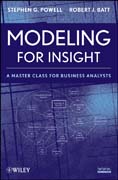
Modeling for Insight is a one-of-a-kind guide to building effective spreadsheet models of ill-structured problems and using them to generate insights. Withits hands-on treatment, this book gives the reader an effective modeling process and specific modeling tools for becoming a master modeler. The real-world examples in the book are drawn from a wide range of fields, including financial planning, insurance, pharmaceuticals, advertising and manufacturing. Modeling for Insight is an ideal book for courses in business modeling, operations research, management science, and engineering at the upper-undergraduate and graduate levels. It is also a valuable resource for consultants and business analysts who build spreadsheets every day to better understand complex problems. INDICE: PART I 1. Introduction 1.0 Models and Modeling 1.1 Well-structuredVersus Ill-structured Problems 1.2 Modeling versus Problem Solving 1.3 Modeling for Insight 1.4 Novice Modelers and Expert Modelers 1.5 Craft Skills in Modeling 1.6 A Structured Modeling Process 1.7 Modeling Tools 1.8 Summary 2. Foundations of Modeling for Insight 2.0 Introduction 2.1 The Modeling Process 2.2 Tools for Modeling 2.3 Presentation Skills 2.4 Summary 3. Spreadsheet Engineering 3.0 Why Use Spreadsheets? 3.1 Spreadsheet Engineering 3.2 Summary PART II 4. A First Example: The Red Cross Problem 4.0 Introduction 4.1 The Red Cross Problem 4.2 Bringing Blood Quality into the Analysis 4.3 Improving and Iterating 4.4 Summary 5. The Retirement Planning Problem 5.0 Introduction 5.1 Retirement Planning (A) 5.2 Retirement Planning (B) 5.3 Retirement Planning (C) 5.4 Presentation of Results 5.5 Summary 6. The Technology Option Problem 6.0 Introduction 6.1 Technology Option (A) 6.2 Technology Option (B) 6.3 Further Refinements 6.4 Presentation of Results 6.5 Summary PART III 7. MediDevice 7.0 Introduction 7.1 MediDevice (A) 7.2 Revising the model 7.3 MediDevice (B) 7.4 Presentation of Results 7.5 Summary 8. Draft Commercials 8.0 Introduction 8.1 Draft Commercials Case 8.2 Problem Formulation 8.3 Influence Diagram 8.4 M1 Model andAnalysis 8.5 M2 Model and Analysis 8.6 M3 Model and Analysis 8.7 M4 Model andAnalysis 8.8 Presentation of Results 8.9 Summary 9. New England College Skiway 9.0 Introduction 9.1 New England College Skiway Case 9.2 Problem Formulation9.3 Influence Diagram 9.4 M1 Model and Analysis 9.5 Analyzing Mountain Capacity 9.6 M2 Model and Analysis 9.7 M3 Model and Analysis 9.8 Considering Uncertainty 9.9 Presentation of Results 9.10 Summary 10. National Leasing 10.0 Introduction 10.1 National Leasing Case 10.2 Problem Formulation 10.3 Influence Diagram 10.4 M1 Model and Analysis 10.5 M2 Model and Analysis 10.6 M3 Model and Analysis 10.7 M4 Model and Analysis 10.8 Presentation of Results 10.9 Summary 11. Pharma X and Pharma Y 11.0 Introduction 11.1 Pharma X and Pharma Y Case 11.2Problem Formulation 11.3 Influence Diagram 11.4 Expected Value or Simulation?11.5 M1 Model and Analysis 11.6 M2 Model and Analysis 11.7 M3 Model and Analysis 11.8 Presentation of Results 11.9 Summary 12. Invivo Diagnostics, Inc. 12.0 Introduction 12.1 Invivo Diagnostics Case 12.2 Problem Formulation 12.3 M1 Model and Insights 12.4 M2 Model and Insights 12.5 M3 Model and Analysis 12.6 M4 Model and Analysis 12.7 Presentation of Results 12.8 Summary Appendix A: Guide to Solver Appendix B: Guide to Crystal Ball Appendix C: Guide to Sensitivity Toolkit Web Resources Solver Crystal Ball Sensitivity Toolkit Spreadsheet Professional Spreadsheets from text
- ISBN: 978-0-470-17555-2
- Editorial: John Wiley & Sons
- Encuadernacion: Rústica
- Páginas: 496
- Fecha Publicación: 07/11/2008
- Nº Volúmenes: 1
- Idioma: Inglés
